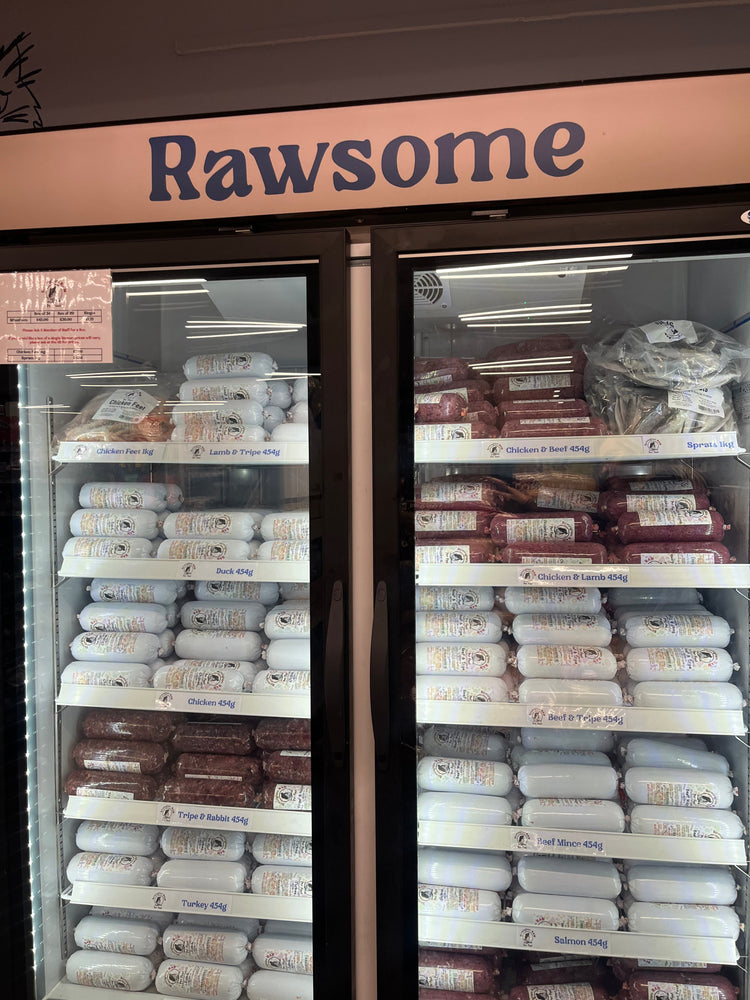Raw vs. Kibble: What’s the Best Diet for Your Dog? - Pet Village

Choosing the right diet for your dog is one of the most important decisions a pet owner can make. With so many options available, the debate between raw feeding vs. kibble continues to be a hot topic among dog owners, vets, and pet nutritionists. But which diet is truly best for your furry friend? Let’s break down the pros and cons of both to help you decide.
What Is a Raw Dog Food Diet?
A raw diet, often referred to as a BARF diet (Biologically Appropriate Raw Food), typically consists of:
-
Raw meat (chicken, beef, lamb, turkey, etc.)
-
Bones (raw, never cooked)
-
Organ meats (liver, kidney, heart)
-
Vegetables & Fruits (carrots, apples, spinach, etc.)
-
Supplements (fish oil, probiotics, vitamins)
Benefits of a Raw Diet:
✅ Better Digestion – Many dogs process raw food more efficiently, leading to smaller, firmer stools.
✅ Healthier Skin & Coat – The high-fat content and natural oils contribute to a shinier coat.
✅ Improved Dental Health – Chewing raw meaty bones can help reduce tartar buildup and maintain healthy gums.
✅ Increased Energy & Muscle Tone – Raw diets are high in protein, which can help build lean muscle.
Downsides of a Raw Diet:
❌ Bacterial Risks – Raw meat can carry harmful bacteria like Salmonella and E. coli. Proper handling is essential.
❌ Nutritional Imbalance – It takes careful planning to ensure your dog gets all the essential nutrients.
❌ Storage & Cost – Raw diets require freezer space and can be more expensive than kibble.
Recommended Raw Dog Food Brands:
What Is a Kibble Diet?
Kibble is the most common commercial dog food and is made by processing ingredients into dry, bite-sized pieces. High-quality kibble contains:
-
Meat proteins (chicken, beef, lamb, fish, etc.)
-
Vegetables & Grains (sweet potatoes, brown rice, peas)
-
Essential nutrients (omega fatty acids, vitamins, minerals, probiotics)
Benefits of a Kibble Diet:
✅ Convenient & Affordable – Easy to store, serve, and purchase.
✅ Balanced Nutrition – Many high-quality kibbles are formulated to meet a dog’s dietary needs.
✅ Supports Dental Health – Some kibble brands are designed to reduce plaque and tartar buildup.
✅ Longer Shelf Life – Unlike raw food, kibble doesn’t require refrigeration.
Downsides of a Kibble Diet:
❌ Highly Processed – Some brands contain artificial preservatives and fillers.
❌ Lower Moisture Content – Can contribute to dehydration if dogs don’t drink enough water.
❌ Possible Allergies – Some kibble contains grains, which can trigger allergies in sensitive dogs.
Recommended Kibble Brands:
Which Diet Is Best for Your Dog?
There is no one-size-fits-all answer. Every dog is different, and factors like age, breed, health, and activity level play a role in determining the best diet. Here are some things to consider:
-
For Active, High-Energy Dogs: A raw diet may provide the protein boost they need.
-
For Busy Owners: Kibble is more convenient and easier to store.
-
For Dogs with Allergies or Sensitivities: A raw diet or grain-free kibble might be better.
-
For Senior Dogs: A mix of kibble and fresh food can be easier to digest.
Can You Feed Both Raw and Kibble?
Yes! Many pet owners choose a hybrid diet, offering both raw food and kibble. However, you should feed them separately (e.g., raw for breakfast, kibble for dinner) since they digest at different rates.
Final Thoughts
Whether you choose raw, kibble, or a mix of both, the key is to ensure your dog gets a balanced, nutritious diet. Always consult your vet before making any major dietary changes.
Looking for high-quality dog food, treats, and toys? Browse our selection at Pet Village and give your furry friend the best! 🐶💙







